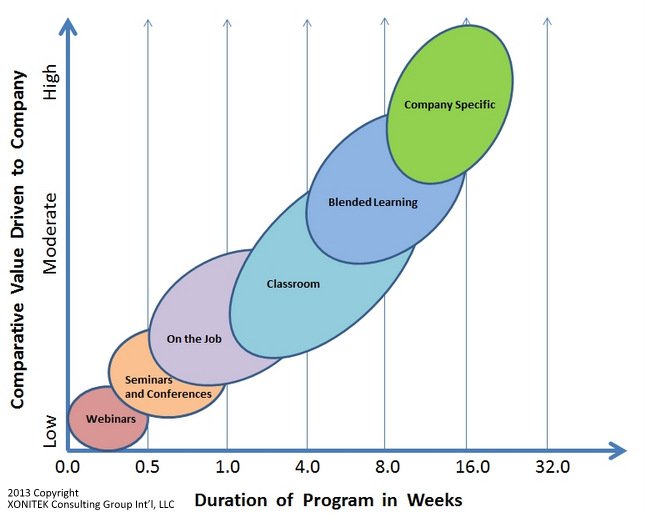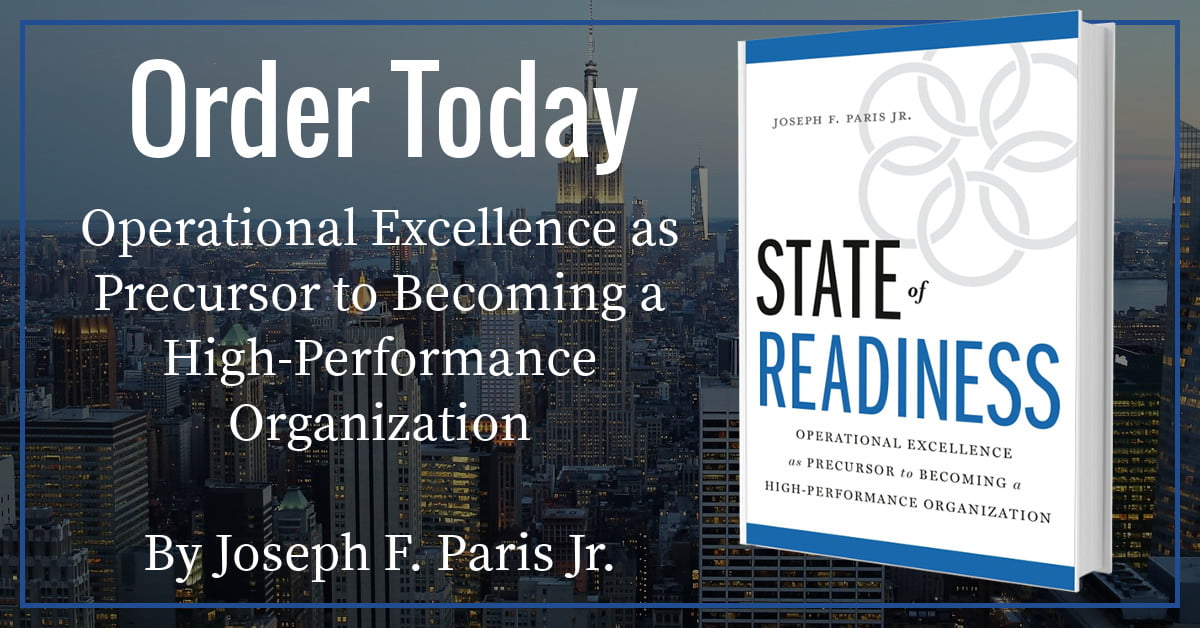Training and Education – What is the correct value for you?
As Continuous Improvement practitioners, it is natural (even a passion) to always seek ways to improve ourselves and the value we drive to our colleagues and the companies for which we work. During our quest for this personal and professional development, sometimes we know precisely which areas we wish to improve our skillsets and where we need to concentrate our efforts, and sometimes we seek to satisfy a curiosity of some subject matter.
Once we decide on what we wish to learn, we need to decide on what level of knowledge and competency we wish to possess at the conclusion of our being taught and, most importantly, we need to ensure that the method we select for conveying of that knowledge and competency to us will yield those expected results. Therefore, during this evaluation process, we must always remember the following corollary; the level of effort required is directly proportional to the depth of the knowledge and competency acquired.
We must also evaluate the “Comparative Value” of the efforts and results, with Comparative Value being defined as; “the investment requirements associated with gaining the knowledge versus the benefit gained to oneself and one’s company.”
When considering “investment requirements”, it’s inadequate to just calculate the direct costs associated with acquiring the knowledge such as; curriculum costs, tuitions, delegate fees, travel, room and board, materials and supplies, etc… We must also consider all of the direct costs associated such as; the time of the employee learning, the time of the employee(s) teaching, the development and maintaining of internal curriculum, delivery medium and infrastructure, etc…
In the chart below, I grade “Comparative Value” as “Low”, “Moderate”, and “High” where:
- Low: Is “Logistical” content. The participant should expect to learn the terminology used, the value derived from proper use of the content, and perhaps some basis applications.
- Moderate: Is “Tactical” content. At this level, the participant should expect to learn how to plan the use of the content, when to deploy, and how to manage.
- High: Is “Strategic” content. At this highest level, the participant should expect to learn how to define objectives in the discipline and be able to communicate how these objectives will be realized.
In addition to “Comparative Value”, one must also keep in mind the credibility of the origin of the content being learned. What are the credentials of the conveyor of knowledge? Do they have the proper experience and success in the field and can they stand as a sufficiently qualified authority on the subject? Here, the student must always keep in mind “Caveat Emptor”, or more commonly known as “let the buyer beware” – especially when it comes to “Certifications”.
Lesson: For instance, I was speaking with a recent University graduate who wished for me to review her Curriculum Vitae (also known as “CV” or “Resume”). I noted that she had earned her “Six Sigma Green Belt Certification” at the University, so I asked to know the details of her Green Belt project. To my surprise, neither she (nor anyone in the class) had worked on a Green Belt project – or any project. All that was required of her to earn her Green Belt was that she had to sit through a week-long classroom education and pass a test. My advice to her was to change her “Certification” to either “Six Sigma Yellow-Belt” or, alternatively, state that she received Green Belt training. |
There is no universally recognized governing body for “Certifications” in the disciplines of Lean Six-Sigma, or every other dimension of Continuous Improvement – nor is there a recognized standard for curriculum or other metrics. And unfortunately, there are many people out there who just want to “pad their resume” and who feel any certification is better than no certification. I have witnessed first-hand some students who don’t even show-up for class, but receive their “Certification” at the end of the class simply because they paid to attend the session. Because of this, those who would hire should also remember “caveat emptor” during the interview and vetting process to ensure the candidate is properly credentialed from a reputable conveyor of knowledge – and has the proper level of practical experience that the position requires. Make sure the “Certification” is worth the paper upon which it is printed.
A simple way to qualify the quality of a “Certification” is simply to listen to how the person announces their certification – are they consciously or subconsciously embarrassed? For instance, I would become immediately suspicious if someone were to simply say to me, “I am a Black Belt” (or whatever) – as opposed to “I am a GE Black-Belt”. In any case, I am going to ask them about their projects and practical experience in great detail to determine the true level of knowledge – since the application of knowledge is where the value is realized.
All this being said; there are organizations that devote themselves solely to training and education of Lean Six-Sigma and related subjects such as the American Society for Quality (ASQ) and the Institute of Industrial Engineers (IIE) – to name just a couple. And there are many companies who have their own internal, and robust, programs such as General Electric, Motorola, and International Paper – again, just to name a few of a great many.
The rest of this article is devoted to the various methods of learning, the investment requirements, their Pros and Cons, and the Comparative Value that should be expected.
Webinars: Learning by attending a webinar is the least-cost and most convenient method of learning, but what you will learn is greatly limited. As such, a webinar is a great way of gaining exposure to a topic (or as a refresher-course for updates to knowledge) – but you should not expect to become proficient in any topic. Would you trust your surgery or the filing of your taxes to someone who learned only by attending a webinar? An additional risk to webinars is that (since they are so inexpensive to produce) those who might charge to attend might not be credible conveyors of the knowledge – and if they are “free”, I can almost guarantee you that (in almost every case) they are merely sales-pitches disguised as learning experiences.
- Expected Investment Requirements: Free to $250 plus minimal “soft-costs”
- Expected Duration: 30 minutes to a half-week
- Pros: Low-cost, short-duration, convenient
- Cons: Don’t expect to learn too much
- Comparative Value: Low
Seminars (and Conferences): Attending Seminars and Conferences is a good way to get a deeper-dive into a subject in a more collegiate setting. One of the most significant benefits of attending a Seminar (or Conference), and one which should not be dismissed, is the ability to interface with peers one-on-one. This interaction and the exchange of practical experiences (if pursued), will enable the participant to better understand the material as it is applied in context, help to build invaluable interpersonal and communication skills, and expand one’s professional network to facilitate problem-solving in the future. One should expect that “Free” seminars will be “sales-pitches” (think along the lines of a pitch for “Timeshares”).
- Expected Investment Requirements: $1,000 to $5,000 including considerable “soft-costs” associated mostly with travel expenses and time-lost.
- Expected Duration: 1-5 days
- Pros: Deeper dive into a subject matter, usually from several perspectives. The ability to network with peers to compare experiences and learn – build relationships and “Social-IQ”
- Cons: Takes considerable time and costs to attend. There is a risk that the speakers will be paying to deliver the content and you are actually sitting in an “infomercial”.
- Comparative Value: Low to Low-Moderate
On-the-Job (OJT): Assuming the OJT program is well developed and structured (which is not to be taken as a given), the successful student should have an understanding of the tools and skillsets necessary to satisfactorily perform the tasks related to carrying-out the responsibilities associated with their position. However, this training will be limited to the performance of tasks and processes. As such, it would be misguided to expect the successful student to apply what they have learned strategically.
- Expected Investment Requirements: $2,500 to $15,000 – mostly internal “soft-costs”
- Expected Duration: Half-week to one month
- Pros: Rapid ramp-up to get you generating value for the company.
- Cons: Usually very vertical content. You learn the job, but not the context.
- Comparative Value: Low-Moderate to Moderate
Classroom Training: Learning by attending a formal class (even if delivered via webcast) will result in the student receiving a much broader and deeper understanding of a subject. Since there is much more “heavy lifting” involved in producing a classroom-delivered curriculum, there is almost always an investment requirement on the part of the student involved and the instances of non-credible conveyors of knowledge greatly diminishes. Even so, you will want to ensure the organization (whether a University, an Institute, a Learning Company, or other entity) has a track-record for success and clearly details the level of effort and the expected take-away for the student.
- Expected Investment Requirements: $5,000 to $20,000 – including internal “soft-costs”
- Expected Duration: 1 to 12 weeks
- Pros: Focused content delivery and ability to work with “outsiders”.
- Cons: Subject matter not taught in the context of the employer.
- Comparative Value: Low Moderate to High Moderate
Integrated Learning: Sometimes referred to as “Blended Learning”, an Integrated Learning program melds several content delivery methods including; webinars, self-study, classroom training, and one-on-one mentoring and coaching. Low-level activity is taken off-line (where the attendance value of the instructor is de minimis), but with a corresponding increased emphasis on individualized mentoring for high-level activity.
- Expected Investment Requirements: $5,000 to $20,000 including internal “soft costs”
- Expected Duration: 4 to 16 weeks
- Pros: A combination of general education and practical experience applied at your place of employment – with greater scheduling flexibility and delivered at a pace that is more compatible with the demands of your work responsibilities.
- Cons: Considerable commitment (on the part of student and employer) to complete.
- Comparative Value: Moderate to High Moderate
Company-Specific Education Programs: Best-in-class companies do not follow the “best-practices” documents created by consulting companies and analysts – they create them themselves. They realize that published “best-practices” are always in the past-tense and, if achieved, would mean they are still years behind the industry leaders. Best-in-class companies create their own education programs by teaching the known tools and methodologies as they are applied, in the context of the company, within the company. These programs merge the delivery platforms and approach associated with Integrated Learning with the company-specific content associated with OJT. If properly and fully developed, this approach and resultant program will yield the highest comparative value for a company by enabling the company to 1) identify what actually needs improving and go about improving it; and also 2) identify, quantify, capture the company’s own best practices and make this content part of the curriculum that the knowledge might be leveraged.
- Expected Investment Requirements: $10,000 to $40,000 (or more) including “soft costs”
- Expected Duration: 8 to 26 weeks
- Pros: Successful completion of the program creates strategic leadership for the company.
- Cons: Immense amount of effort. Program candidates need to be properly vetted to ensure they can complete the program and will remain with the company so that the investment on the part of the company in the individual is recouped.
- Comparative Value: High Moderate to High

However, even within these content and delivery options there are factors which must be considered in creating a Company-Specific Education Program such as, “Who is responsible for the development and delivery program?”, including; the curriculum, education, training, coaching, and mentorship.
The development and deployment options can be defined in one of four ways:
1) Internal: is when the program is developed and deployed by resources owned by, and mostly within the company. The challenge here, and why almost all of these initiatives fail to realize their potential, is that the efforts, energy, and talent required to successfully develop and deploy such a program are “non-core to” the company. The result is usually a program which: lacks commitment from the company, is not aligned and coordinated with the company’s strategies, has an inbred view of the company (killing innovation and inhibiting transformational change) and whose critical components (resources, content, and delivery mechanism) are a hodge-podge – certainly not a “be all you can be” commercial.
2) External: is when the company subcontracts-out the development and deployment of the program to resources external to the company. The weakness in this approach is that the program is almost always “canned” and not relevant to the business. The students are exposed to mostly generic content and must imagine how what they are learning is relevant to the needs and challenges of their business. The teachers have a very difficult time acting as facilitators because of their fixation on the curriculum (i.e. the tools), and not how they are applied in any given circumstance. The end result is usually greater than the under-funded, under-respected, efforts in #1 above, but still lack the impact expected of a program (after the low-hanging fruit is consumed).
3) Hybrid: is when there exists a partnership between the internal resources (who have intimate knowledge of the business strategy and their industry) and external resources (who have a command of the tools, have developed professional curriculum which they keep current, have “fresh eyes”, and are expert educators and mentors). This approach allows a company to maintain concentration on its core value-proposition, but leveraging its business and industry knowledge into a program framework and delivery mechanism which pre-exists and does not have to be invented.
My experience has been that this is the most successful approach in the development and deployment of a program and yields the greatest net benefit to the company. By embracing this approach, each and every party brings to the program their core competencies with the result being: rapid design and launch, low and flexible on-going investment requirements, clearer metrics which are easier to monitor, a focus on the company strategy and not the nostalgia or relationships, a vested interest realizing (and reporting) results, and in maintaining the momentum.
4) External-Internal: is when the company is determined to build its own consultancy practice internally. The challenge here is bandwidth and diversity.
A company needs bandwidth because developing, deploying, and maintaining an internal business unit dedicated solely to improving one’s company takes a lot of energy. If the initiative only half-starts because of a lack of resources or focus, it will be seen for what it is – a failure which won’t be given a second chance. And a company needs diversity otherwise the program will be inbred and will never learn to challenge the status-quo, transformational change will never be allowed, and the program will fail.
However, if the company has enough bandwidth and diversity, then there is a strong chance that the program can be as successful, or even marginally more successful, than the Hybrid (above). The risk is that the new internal consulting group becomes so great that the company decides to spin it off as its own business unit – like Tata Consulting – leaving the company close to where it started.
It is important to note that Continuing Education is critical to any professional (and their company) who wants to remain on top of their game – but, as Continuous Improvement Professionals, you already know that.
About the Author
 Joseph F Paris Jr is the Founder and Chairman of the XONITEK Group of Companies; an international management consultancy firm specializing in all disciplines related to Operational Excellence, the continuous and deliberate improvement of company performance AND the circumstances of those who work there – to pursue “Operational Excellence by Design” and not by coincidence.
Joseph F Paris Jr is the Founder and Chairman of the XONITEK Group of Companies; an international management consultancy firm specializing in all disciplines related to Operational Excellence, the continuous and deliberate improvement of company performance AND the circumstances of those who work there – to pursue “Operational Excellence by Design” and not by coincidence.
He is also the Founder of the Operational Excellence Society, with hundreds of members and several Chapters located around the world, as well as the Owner of the Operational Excellence Group on Linked-In, with over 25,000 members.
For more information on Paris, please check his Linked-In Profile at: http://de.linkedin.com/in/josephparis








